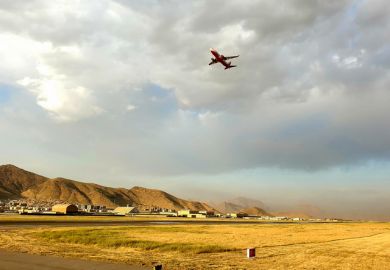Philip Anderson eyes a braver, newer world and gets lost in the hubbub
It is very seldom that reading a book for review is really a chore for me.
My curiosity even to hear what slant the author may take on familiar material, not to mention my voracity for new facts and ideas, is almost insatiable. I read the backs of cereal boxes at breakfast. But somehow Susan Greenfield's Tomorrow's People was an exception to the rule - I had to grit my teeth and really work at each chapter. The book is well enough written, with occasional felicities; and the theme, "How 21st-century technology can change the way we think and feel", should have intrigued me.
I began to think that I must be the kind of older person well described somewhere in the middle of the book as having a "crystalline" intelligence, capable only of relating the new to the already known, incapable of the flexibility to appreciate the radically innovative effects of new technology.
For about seven of the ten chapters, I slogged through a dense forest of what you might call technohype, or even "future schlock", the sort of thing that comes from the pens of writers such as Michio Kaku, Mihalyi Czikszentmihalyi and the author Ray Kurzweil, all of whom are quoted, Kurzweil extensively.
Since Greenfield has the entire 21st century to work with, she can and does speculate that the wildest dreams not only of the historically overoptimistic artificial intelligence community and other information scientists, but even of a number of sci-fi writers, are likely to come true. On each of a sequence of subjects, such as lifestyle and reproduction, she brings forward in rapid fire the wonders that the future holds for us. For instance, in the second chapter, on lifestyle, within a few pages she had set my head spinning with "lighter-than-air megastructures, or oxygenated subocean habitats", the "hyperhouse" in which the floorplan, walls and appliances are all flexibly located, virtual rooms in which the walls and windows present whatever information or aspect one calls for; "inside vs outside might become a thing of the past", and that people may need a "reality room" where they can relax away from information technology. Then "the world itself could become the interface", whatever that means and however one might do it. A few pages further on, at random, "even the bright colours of unmodified carrots, spinach and tomatoes would seem dull and unappetising compared with their iridescent modern counterparts" - and, turning a couple more pages, "even your family members can be virtual: they can be of whatever age, gender, sexual orientation, in whatever number you wish..." And, of course, one's health and wellbeing are automatically monitored.
Only at the end of the chapter does one come back to some kind of serious consideration of what such an environment might mean. Greenfield asks, for example, whether one's relationship to reality has not, by this time, decayed almost to zero - would there remain any sense that there is a hard, unresponsive, real reality anywhere? This and many other questions about the effects on the individual have, of course, arisen in one's mind long since - but did one have to go through the 30 pages of hyped futurology to get there?
Then the reader must work through chapters on robots, work, reproduction, education and science, each containing another heterogeneous mass of information, overstuffed but under-evaluated. The topic of robots includes the various schemes for coupling "silicon" and "carbon" intelligences, that is to say, enhancing our capabilities by computerising us (Jaron Lanier, incidentally, has written convincingly about how fundamentally difficult interfacing digital technology with the operating systems of the body and mind will really be). As for the nightmare scenario of being taken over by our own creations, which so exercises Bill Joy of Sun Microsystems, Greenfield sensibly pooh-poohs that particular bugaboo, having as a neuroscientist some appreciation of the massive leaps in understanding necessary before we produce really autonomous, self-aware machines. Even so, the possibilities she mentions seem endless.
Considering work, she details some of the amusing history of past predictions - G. B. Shaw and J. M. Keynes predicted that by now we should be working only about two hours a day. But of course what changes is the nature of work and, massively, the composition as to age, training and flexibility of the workforce. Here, for some reason, she has a brief excursion into energy supply, where her biological and IT background, for once, fails her - she takes seriously President George W. Bush's fuel cells and hydrogen economy, for instance, which simply move the hot potato from one hand to the other.
Reproduction, in the genomics age, is a fertile field for the imagination, and most of the possible changes are rung on cloning, artificial genomes and life prolongation. A favourite fantasy is the "24th chromosome", on which one hangs all kinds of protective or life-enhancing genes for use as needed. And here too much is made of the fact that with in vitro methods, anyone can be the parent of anyone (or anything) so long as the parent is older than the child (... think).
"Education": here again there is some good sense but just too much information - the good sense being the awareness that just because all information is available at the fingertips one cannot do without education, which is not just, or even mostly, about facts. The overdose of information comes from a heavy injection of psychology and neuroscience of all sorts.
On science, true to Greenfield's own specialty, there is quite a perceptive and perspicuous discussion of the great problem of consciousness, and a discussion, in passing, of the benefits of interdisciplinarity and the endless frontier of complexity. As with the weakness on energy, there was all too much credibility given to the recent fad for "nanotechnology", which to my mind has been partly evolved to resuscitate a moribund hardware science.
With the first seven chapters under our belts, we come to "Terrorism", "Human nature" and the "Future". I sense, somewhere in the middle of "Terrorism", that the author experienced - or intended all along? - a change of heart. After regaling us with all the dreadful possibilities inherent for terrorism in the 20th century, which will become much more refined for the 21st, she begins to think about why this should be a problem in the first place - which brings her to the questions that had been on my mind almost from the first page of the book, which are: first, what about the many of the West's population, and most of the rest, who cannot afford - and may not be able to tolerate - any of this future? A corollary - are there potentialities in the human race, especially when divided by the effects of technology, more dangerous than anything the robots can do to us? Second, what about human nature? Is it not deeply ingrained in the mechanism of our minds and bodies, and dare we replace it with something else based on genomics and information technology? Third, won't further breaking up family and community, and the literate culture, and replacing them with whatever comes out of technology - chat groups, websites - lead to an even greater proliferation of cults and other aberrant, intellectually isolated social groups? Can an evaporating connection to reality support democracy?
To my mind, the great conflict of our times is between the Enlightenment culture of tolerance, humanism and individuality, and the coercive and dogmatic fundamentalist cultures, whether in the West or the East. What Greenfield correctly foresees is that information technology and its technological comperes simultaneously sap our social coherence and strengthen fundamentalism, especially among those left behind economically or intellectually. In her final chapters, Greenfield completes her turnaround and argues, often with some eloquence, in favour of taking thought, while we still can, about such measures as using IT and modern technology to improve the lot and to alleviate the ignorance of the masses of humanity. She lays out a number of alternative scenarios for the future, each more desperately pessimistic than the last. And in the end, the best she can do is plead for the "ultimate priority" of "not just the preservation, but also the celebration, of individuality".
Greenfield has an important and chilling message to impart. Somehow, out of all this mass of miscellany she has read the trend line of the future and identified a number of tendencies towards disaster, which, in fact, one can see in process all around us. She is correct to warn us of them. But if at least part of her isn't all in favour of the indiscriminate application of the technological possibilities, why does she dwell on them in such loving detail - and why does she denigrate those who push back against them as "cynics" or "technophobes"? In a preface, Greenfield submits that in her mind the book began as a novel. Frankly, a novel might have made her point in a much cleaner way and certainly she would have needed to have been more selective in her choice of technological tricks to present. As it stands, despite my relief at the conclusions reached, this book is flawed.
Philip W. Anderson, Nobel laureate, is emeritus professor of physics, Princeton University, New Jersey, US.
Tomorrow's People: How the 21st Century is Changing the Way We Think and Feel
Author - Susan Greenfield
Publisher - Allen Lane The Penguin Press
Pages - 284
Price - £20.00
ISBN - 0 7139 9631 5
Register to continue
Why register?
- Registration is free and only takes a moment
- Once registered, you can read 3 articles a month
- Sign up for our newsletter
Subscribe
Or subscribe for unlimited access to:
- Unlimited access to news, views, insights & reviews
- Digital editions
- Digital access to THE’s university and college rankings analysis
Already registered or a current subscriber?



